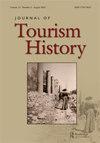海滩上的尸体:1870-1940年,雅典海滨的海浴
IF 0.9
Q4 HOSPITALITY, LEISURE, SPORT & TOURISM
引用次数: 0
摘要
摘要本文从1870-1940年的希腊报纸上,即希腊国际大规模旅游业出现之前的时期,在海水浴的背景下,探讨了雅典海滨的身体与海滩之间的关系。这种关系的体验、表现和调节方式与阶级、性别和性取向方面的权力动态密不可分。同样,海水浴是一种被医生、报纸记录者和体操运动员赋予意义的活动,而海滩则成为当局和游泳者之间争论的场所。在19世纪的最后几十年里,工人阶级男人的裸体引起了中产阶级观察家的激烈反应。从1910年起,当充满活力的海滩文化已经形成时,贝氏混合物的传播凸显了女性的身体及其壮观之处。从这个角度来看,海滩可以被认为是现代女性表达方式出现的社会舞台之一。本文章由计算机程序翻译,如有差异,请以英文原文为准。
Bodies at the beach: sea bathing on the Athenian seafront, 1870–1940
ABSTRACT
Drawing from Greek newspapers from the period 1870–1940, which preceded the advent of the international massive tourism in Greece, this article examines the relationship between bodies and the beaches on the Athenian seafront within the context of sea bathing. The ways in which this relationship was experienced, represented and regulated became inextricably linked with power dynamics articulated in terms of class, gender and sexuality. Similarly, the practice of sea bathing emerged as an activity vested in meaning that was ascribed by doctors, newspaper chroniclers and gymnasts, while beaches became arenas of contention between the authorities and bathers. Over the last decades of the nineteenth century, the naked bodies of working-class men provoked the fierce reactions of middle-class observers. From 1910 onwards, when a vibrant beach culture had already taken shape, the dissemination of bains-mixtes brought to the fore the female body and its spectacularisation. From this perspective, beach could be considered as one of the social arenas where the expression of modern womanhood emerged.
求助全文
通过发布文献求助,成功后即可免费获取论文全文。
去求助
来源期刊

Journal of Tourism History
HOSPITALITY, LEISURE, SPORT & TOURISM-
CiteScore
0.60
自引率
0.00%
发文量
16
期刊介绍:
The Journal of Tourism History is the primary venue for peer-reviewed scholarship covering all aspects of the evolution of tourism from earliest times to the postwar world. Articles address all regions of the globe and often adopt interdisciplinary approaches for exploring the past. The Journal of Tourism History is particularly (though not exclusively) interested in promoting the study of areas and subjects underrepresented in current scholarship, work for example examining the history of tourism in Asia and Africa, as well as developments that took place before the nineteenth century. In addition to peer-reviewed articles, Journal of Tourism History also features short articles about particularly useful archival collections, book reviews, review essays, and round table discussions that explore developing areas of tourism scholarship. The Editorial Board hopes that these additions will prompt further exploration of issues such as the vectors along which tourism spread, the evolution of specific types of ‘niche’ tourism, and the intersections of tourism history with the environment, medicine, politics, and more.
 求助内容:
求助内容: 应助结果提醒方式:
应助结果提醒方式:


